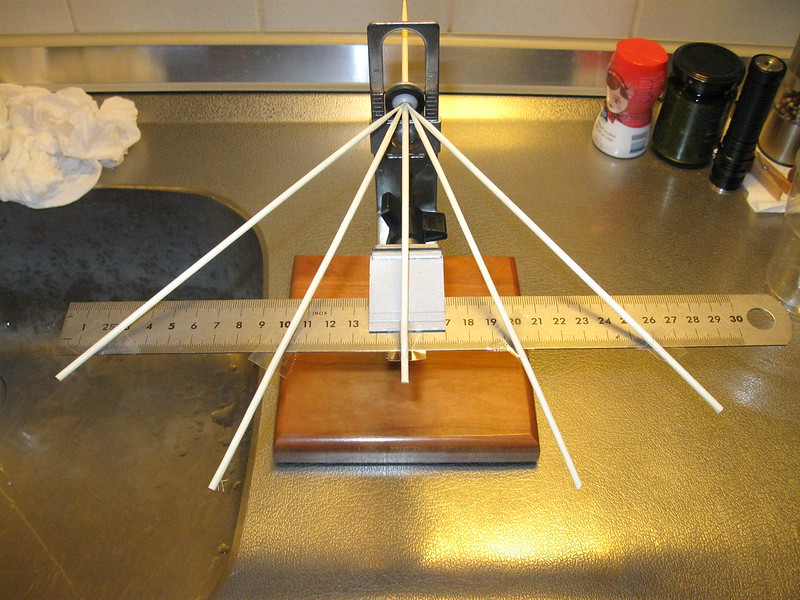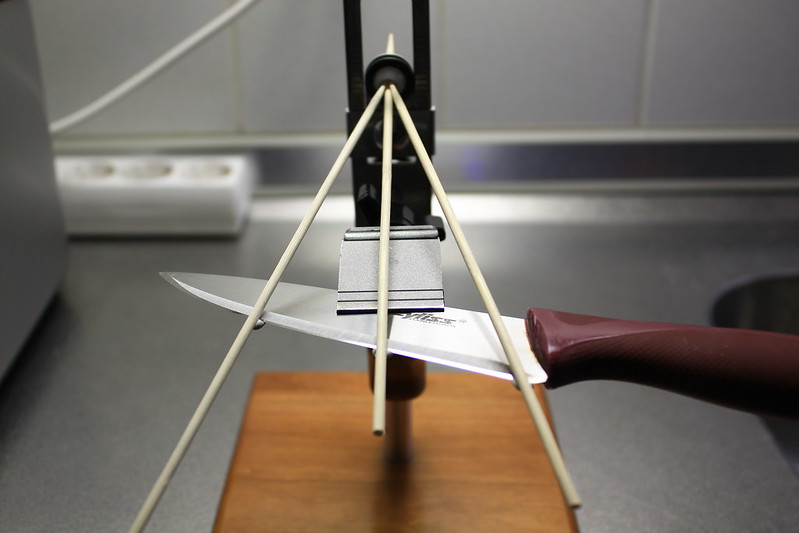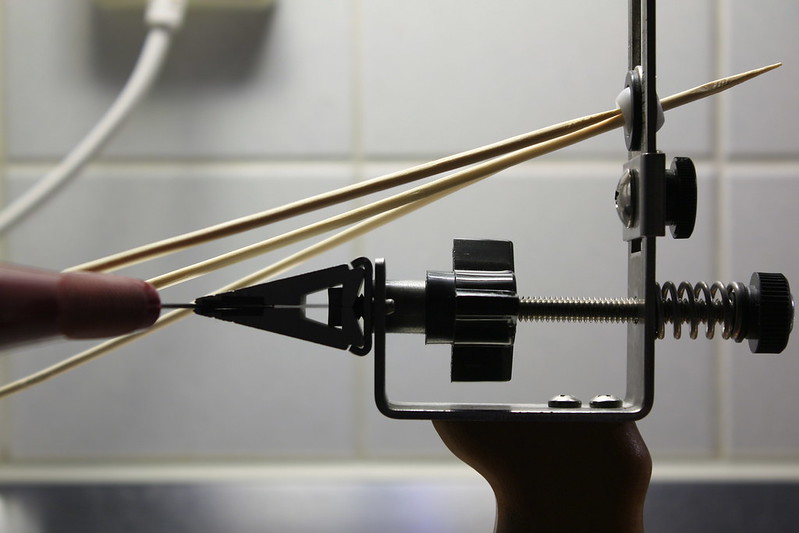Advanced alignment guide
Recent › Forums › Main Forum › Product Announcements › Advanced alignment guide
- This topic has 189 replies, 22 voices, and was last updated 05/24/2016 at 3:13 am by
 M1rrorEdge.
M1rrorEdge.
-
AuthorPosts
-
02/16/2016 at 11:59 am #31316
I missed this before, (and this may be dumb), but what if you used a tanto blade to take measurements? Not curved I know, but it gives a flat area at an angle to measure from?
That was a great idea. I just checked it out with a tanto blade. The rotation of the stone is very obvious on the forward portion of the knife. I haven’t figured out how to measure the rotation precisely, but it is at least no less than 5°. What changes with the tanto is that the stone rests flat in the new plane. When you take the stone back to the straight edge and project that plane forward, it’s obvious that only the trailing edge of the stone will be in contact with the in the tanto portion, as long as you keep the stone steady in the original plane. At 20° along the straight portion, the tanto portion measured roughly 18° when using the o-ring method.
-Clay
02/16/2016 at 3:15 pm #31331Clay, et al, I want to try something. How do I post a video ? Do I just make one and make sure it is smaller than 512 KB ?
02/16/2016 at 3:19 pm #31332Clay, et al, I want to try something. How do I post a video ? Do I just make one and make sure it is smaller than 512 KB ?
The easiest way is to post it to YouTube and then paste the URL here. You can leave it “Unlisted” in YouTube so the whole world isn’t watching it if you prefer.
-Clay
1 user thanked author for this post.
02/17/2016 at 9:52 am #31349cbwx34 wrote:
I missed this before, (and this may be dumb), but what if you used a tanto blade to take measurements? Not curved I know, but it gives a flat area at an angle to measure from?
That was a great idea. I just checked it out with a tanto blade. The rotation of the stone is very obvious on the forward portion of the knife. I haven’t figured out how to measure the rotation precisely, but it is at least no less than 5°. What changes with the tanto is that the stone rests flat in the new plane. When you take the stone back to the straight edge and project that plane forward, it’s obvious that only the trailing edge of the stone will be in contact with the in the tanto portion, as long as you keep the stone steady in the original plane. At 20° along the straight portion, the tanto portion measured roughly 18° when using the o-ring method.Cool…makes me about 1 for 5 on the day.
If it gets to the point of measuring angles on a curve… it might also be easier (at least for the digital cube’s calculating), to rotate the WE so that the blade is horizontal instead of vertical.
02/17/2016 at 10:17 pm #31358Here is my attempt to duplicate Anthony Yan’s Matlab video in the real world. I am not sure if my cheesy optical setup cuts it. What do you guys think ?
I took lots of video in a prototype environment and did my best to paste it together and embed here from Youtube (unlisted). Running the stones on a level flat metal bar kept the stones parallel to the line grid.
However, running the stones on a flat metal bar which was NOT level did not. This can be seen in my video. Is this correct ?
The knife I used was similar to Yan’s chef knife.
I would like to try and draw some conclusions but I wanted feedback whether the images are fooling me while going along curves.
02/17/2016 at 11:39 pm #31359Anonymous
Inactive- Topics: 14
- Replies: 427
How precise is the angle of the knife to the table that holds the lines? if its off one degree to the left or right it will magnify the path of the rod to what ever deviation the knife is to the table. Not only does the table have to be square, so does the knife. All I know is my knives are wicked sharp, with little effort, thank God, IM only asking my knives to slice a tomato, and not be subjected to electron microscopic analysis. I could not take the disappointment. When you keep your bar low, it makes you a happy person.
1 user thanked author for this post.
02/18/2016 at 6:50 am #31360Running the stones on a level flat metal bar kept the stones parallel to the line grid. However, running the stones on a flat metal bar which was NOT level did not. This can be seen in my video. Is this correct ?
I don’t think so… like I said in my other post, the angle that the stone sharpens at is what you see when you site along the edge. So even though it’s changing in relation to the paper, I don’t believe that it’s changing in relation to the metal bar.
Edit to add: Not sure if it means anything, but I noted in rewatching the entire video, in all the examples where the camera sites down the edge, it basically intersects the paper at a single point, but in the angled metal bar, it appears diagonal across the paper.
p.s. What is the top video showing? That bottom video was a good idea.
02/18/2016 at 11:22 am #31364Great video, Redheads. cbwx34 is right in that placing the point of the edge dead center in your video image would have produced a slightly different and more correct angular motion.
cbwx34, it makes perfect sense to me that a straight and level bar would have no angular change, when seen from this perpective. With anything that has a variability in the height of the edge, the angle of the rod/stones would have to change – again, in this perspective, which is only looking at the angle of the stone relative to dead vertical. The angle as seen on the edge is dependent somewhat on the distance of the edge from the pivot point at any given point along that edge. With an edge having a perfect arc matching the O-ring sweep, the bevel angle would stay constant.
02/18/2016 at 12:14 pm #31366Great video, Redheads. cbwx34 is right in that placing the point of the edge dead center in your video image would have produced a slightly different and more correct angular motion. cbwx34, it makes perfect sense to me that a straight and level bar would have no angular change, when seen from this perpective. With anything that has a variability in the height of the edge, the angle of the rod/stones would have to change – again, in this perspective, which is only looking at the angle of the stone relative to dead vertical. The angle as seen on the edge is dependent somewhat on the distance of the edge from the pivot point at any given point along that edge. With an edge having a perfect arc matching the O-ring sweep, the bevel angle would stay constant.
Hey, thanks for the reply.
Just for the sake of clarity, are you saying that in this photo…
That A would sharpen at a lower angle then B? (Assume it’s a straight line).
Attachments:
You must be logged in to access attached files.
02/18/2016 at 1:13 pm #31368I stand corrected.
I think my video with the cheesy optical setup will not work (ie. cross overs of parallel lines to indicate relative angle changes) unless the camera is orthogonally attached to the rod/stone (like with a GoPro setup).
The first video is legit and it comes from Appendix A of Anthony Yan’s paper: https://knife.wickededgeusa.com/forums/topic/geometry-and-kinematics-of-guided-rod-sharpeners. It is hard to explain but it is basically a mathematical animation to visualize the angle change along the knife edge based on where you position the knife in the holder (which affects the position of the spherical pivot).
Back to the angle cube or maybe some GoPro.
02/18/2016 at 3:58 pm #31372CB: yes, absolutely. The angle at A will be lower than at B.
The angle of the bevel is a function of the right triangle, with the adjacent side being the height between the pivot point and the point of contact and the opposite side being the horizontal distance between the pivot point and the vertical axis of the blade. The higher the point of contact, the lower the angle will be. The blade being skewed relative to vertical would have little or no effect on the angle at any one point.
02/18/2016 at 4:40 pm #31378CB: yes, absolutely. The angle at A will be lower than at B. The angle of the bevel is a function of the right triangle, with the adjacent side being the height between the pivot point and the point of contact and the opposite side being the horizontal distance between the pivot point and the vertical axis of the blade. The higher the point of contact, the lower the angle will be. The blade being skewed relative to vertical would have little or no effect on the angle at any one point.
Ok, so here’s what I don’t get. How about now…
… which is the same knife now level, with the WE clamp now angled. Because the way I see it, the pivot, which travels in a circle, has no “idea” what the orientation of the clamp is. So, basically the picture with the clamp angled and the blade now level, is no different than this…
… which I believe everyone agrees that the angle doesn’t change (between A and B). That’s why I believe that the angle doesn’t change in the first picture (where the knife is angled).
So, am I missing something?
Attachments:
You must be logged in to access attached files.
02/18/2016 at 4:47 pm #31385Curtis your demonstration w/ the floss is what convinced me that it doesn’t change on a straight line…
But In this case it looks like it would otherwise why can you move the same knife forward and back ward in the vise to find the sweet spot in the belly/tip area, and have it remove sharpie at different areas? Tilting the blade essentially moves the knife forward and backward… if you tilt the WEPS like you did it is very obvious. But somehow it changes or the shapie removal would not change. Unless you were meaning a perfectly straight line (which you may have said lol)
02/18/2016 at 5:00 pm #31386Yeah… just talking about the straight portion.
02/18/2016 at 5:39 pm #31387I think you might be wrong. Analog to your demonstration with the floss, I made two pictures with a ruler in my KME sharpener.
It is obvious when looking at the side view, the angle does not change.


I just made two more photos with a knife clamped at an angle and now I clearly see a change in the angle when looking at the side view.


Unless I am wrong, I think that with the ruler, the pivot is parallel with the edge along the entire length while it changes with the ruler/knife placed at an angle.
Frans
-
AuthorPosts
- You must be logged in to reply to this topic.



